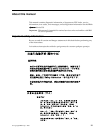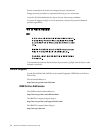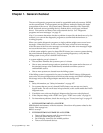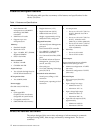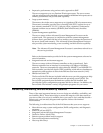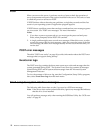
Chapter 2. General information 5
• Impressive performance using an innovative approach to SMP
The server supports up to two Pentium III microprocessors. The server comes
with one microprocessor installed; you can install an additional microprocessor to
enhance performance and provide SMP capability.
• Large system memory
The memory bus in the server supports up to 4 gigabytes (GB) of system memory.
The memory controller provides error correcting code (ECC) support for up to
four industry standard PC133, 3.3 V, 168-pin, 8-byte, registered, synchronous-
dynamic-random access memory (SDRAM) dual inline memory modules
(DIMMs).
• System-management capabilities
The server comes with an Advanced System Management Processor on the
system board. This processor, in conjunction with the systems-management
software that is provided with the server, enables you to manage the functions of
the server locally and remotely. The Advanced System Management Processor
also provides system monitoring, event recording, and dial-out alert capability.
Note: The Advanced System Management Processor is sometimes referred to as
the service processor.
Refer to the documentation provided with the system-management software for
more information.
• Integrated network environment support
The server comes with two Ethernet controllers on the system board. Each
Ethernet controller has an interface for connecting to 10-Mbps or 100-Mbps
networks. The server automatically selects between 10BASE-T and 100BASE-TX.
Each controller provides full-duplex (FDX) capability, which allows simultaneous
transmission and reception of data on the Ethernet local area network (LAN).
• IBM ServerGuide CDs
The ServerGuide CDs that are included with the server provide programs to help
you set up your server and install the network operating system (NOS). The
ServerGuide program detects the hardware options that are installed, and
provides the correct configuration programs and device drivers. In addition, the
ServerGuide CDs include a variety of application programs for your server.
Reliability, availability, and serviceability features
Three of the most important features in server design are reliability, availability, and
serviceability (RAS). These factors help to ensure the integrity of the data stored on
your server; that your server is available when you want to use it; and that should a
failure occur, you can easily diagnose and repair the failure with minimal
inconvenience.
The following is an abbreviated list of the RAS features that your server supports.
• Menu-driven setup, system configuration, RAID configuration, and diagnostic
programs
• Power-on self-test (POST)
• Integrated Advanced System Management Processor
• Predictive Failure Alerts (PFA)
• Remote system problem-analysis support
• Power and temperature monitoring
• Hot-swap drive bays



